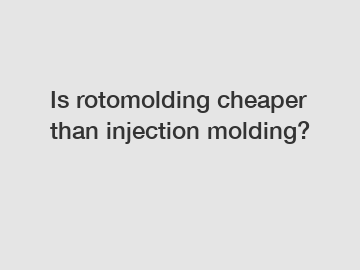Is rotomolding cheaper than injection molding?
Is Rotomolding Cheaper than Injection Molding?
When comparing rotomolding and injection molding, cost is often a critical factor. To answer the question directly, yes, rotomolding is generally cheaper than injection molding. However, to fully understand the reasons behind this cost difference, it is necessary to delve into the process and discuss the implications and impact.
Rotomolding is a manufacturing process that involves heating a plastic resin inside a hollow mold and rotating it bi-axially to create a desired shape. On the other hand, injection molding uses a high-pressure injection of molten plastic into a mold. While both processes have their advantages and applications, rotomolding stands out as the more cost-effective option.

One of the main reasons why rotomolding is cheaper than injection molding is the simplicity of the equipment involved. Rotomolding machines are less complex and require lower maintenance compared to injection molding machines. This translates into reduced initial investment and operating costs for manufacturers utilizing rotomolding techniques.
Furthermore, rotomolding allows for the use of less material compared to injection molding. The rotomolding process evenly distributes the plastic resin inside the mold, resulting in uniform wall thickness. In contrast, injection molding can often lead to excess material being used due to uneven distribution or overcompensation for shrinkage. The efficient material usage in rotomolding not only reduces costs but also promotes sustainability by minimizing waste.
Additionally, the lower tooling costs associated with rotomolding contribute to its cost-effectiveness. Injection molding typically requires expensive and complex molds that are designed to withstand high-pressure injections. Conversely, rotomolding molds are simpler and more affordable, making them readily accessible and cost-efficient. This makes rotomolding an ideal choice for small or medium production runs as well as custom-designed products.
The cost advantages of rotomolding extend beyond the manufacturing process itself. The versatility of rotomolding allows for the production of large, complex, and durable parts without the need for costly secondary operations. Unlike injection molding, which often requires additional machining or assembly processes, rotomolded parts can be manufactured in a single operation, reducing labor costs and increasing overall efficiency.
In conclusion, while rotomolding and injection molding both have their merits, rotomolding generally proves to be the more cost-effective option. Factors such as simpler equipment, efficient material usage, lower tooling costs, and reduced need for secondary operations all contribute to the cost advantages of rotomolding. Manufacturers looking to optimize their production costs, especially for smaller production runs or custom-designed products, should consider incorporating rotomolding into their manufacturing processes.
If you want to learn more, please visit our website led bulb cover injection blow molding machine, Chemical Can Blow Molding Machines, jerry can blow molding machine.
127
0
0


Comments
All Comments (0)